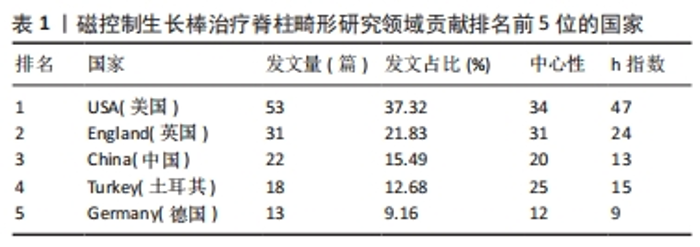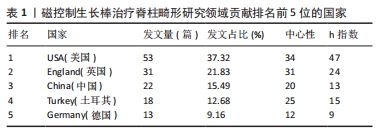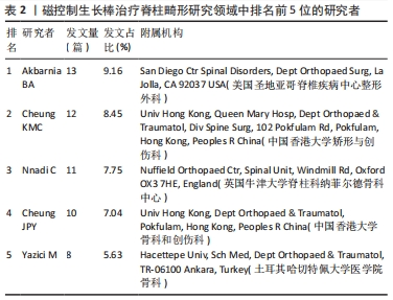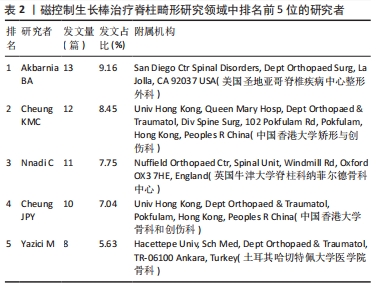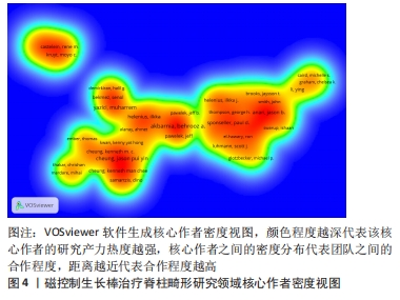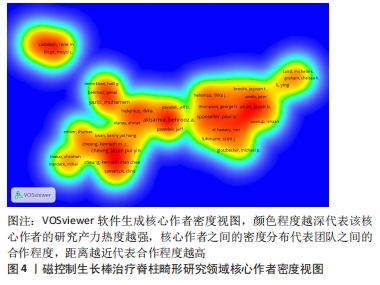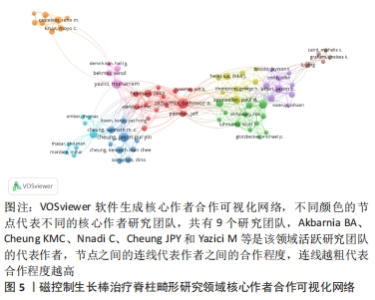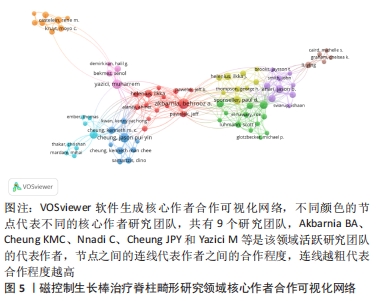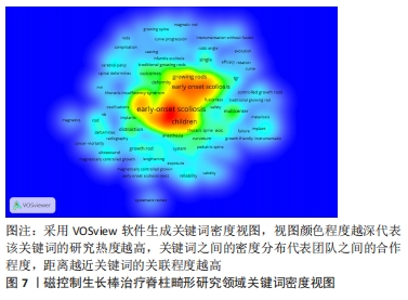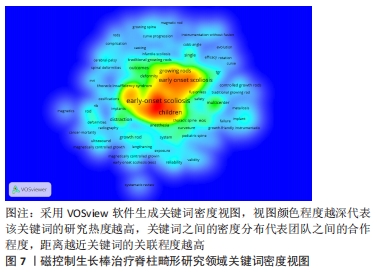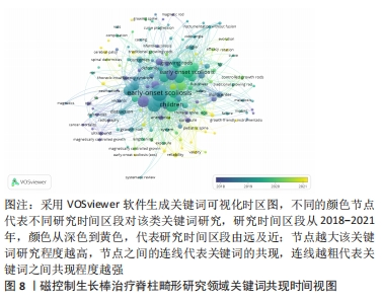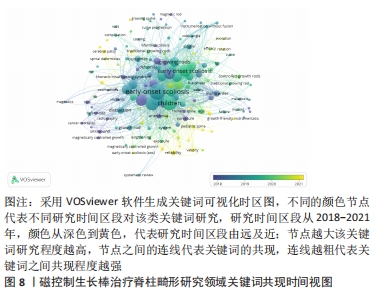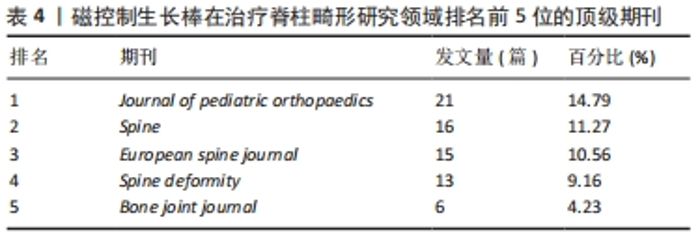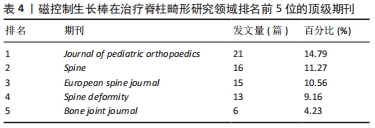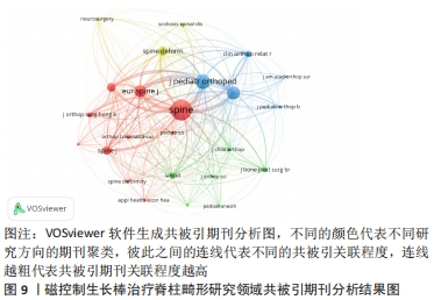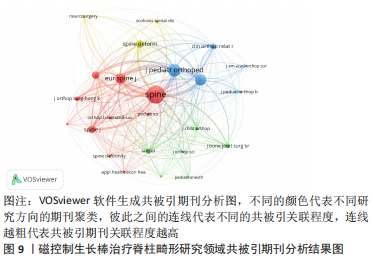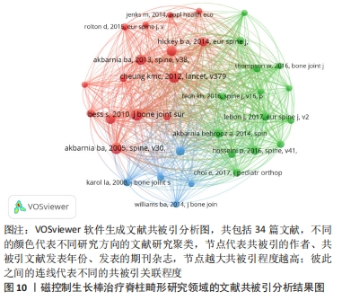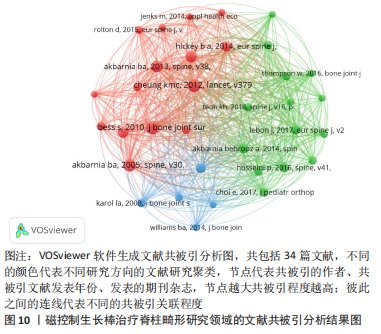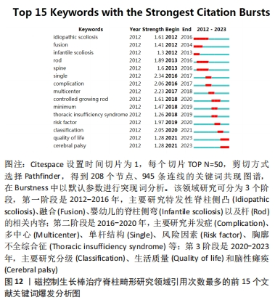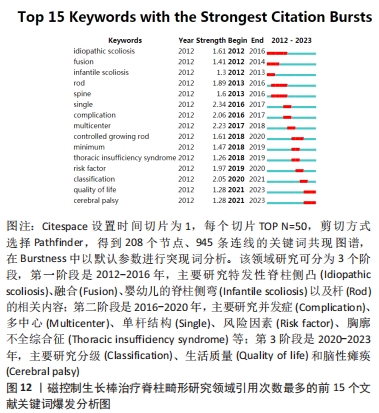Chinese Journal of Tissue Engineering Research ›› 2024, Vol. 28 ›› Issue (15): 2323-2329.doi: 10.12307/2024.379
Previous Articles Next Articles
Visualization analysis of magnetically controlled growing rod in treatment of spinal deformities
Ye Xiaolong1, Ma Yuan2
- 1Xinjiang Medical University, Urumqi 830000, Xinjiang Uygur Autonomous Region, China; 2First Department of Spinal Surgery, Sixth Affiliated Hospital of Xinjiang Medical University, Urumqi 830092, Xinjiang Uygur Autonomous Region, China
-
Received:2023-06-06Accepted:2023-07-08Online:2024-05-28Published:2023-09-19 -
Contact:Ma Yuan, Chief physician, Doctoral supervisor, First Department of Spinal Surgery, Sixth Affiliated Hospital of Xinjiang Medical University, Urumqi 830092, Xinjiang Uygur Autonomous Region, China -
About author:Ye Xiaolong, Doctoral candidate, Xinjiang Medical University, Urumqi 830000, Xinjiang Uygur Autonomous Region, China -
Supported by:National Natural Science Foundation of China, No. 82260446 (to MY)
CLC Number:
Cite this article
Ye Xiaolong, Ma Yuan. Visualization analysis of magnetically controlled growing rod in treatment of spinal deformities[J]. Chinese Journal of Tissue Engineering Research, 2024, 28(15): 2323-2329.
share this article
Add to citation manager EndNote|Reference Manager|ProCite|BibTeX|RefWorks
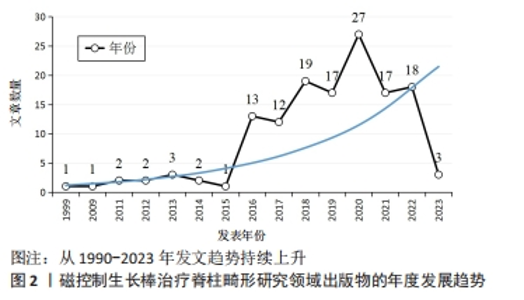
2.1 文献检索结果 共检索到185篇关于磁控制生长棒研究领域的文章,根据纳入排除标准进行额外的人工筛选,审核文章标题,阅读文章摘要,排除文献43篇。共筛选出142篇文章,再通过精读文献,排除4篇,最后共纳入符合要求的文献138篇,包括116篇研究文章,22篇综述。 2.2 磁控制生长棒在治疗脊柱畸形研究领域文献发文趋势 2015年此领域发表了1 篇文章,并在接下来的几年里发表文章数出现增长。2016-2020年,研究数量达到了高峰。2020年共发表文章27篇,创下全年最高水平。总体而言,出版物数量呈上升趋势,说明对磁控制生长棒领域的努力和探索逐渐增多。图2绘制了出版物的年度发展趋势,横坐标是发表年份,纵坐标是发文数量,从1999-2020年,年度文章总数显著增加(P < 0.05)。每年发表的文章数量都在逐渐增加。"
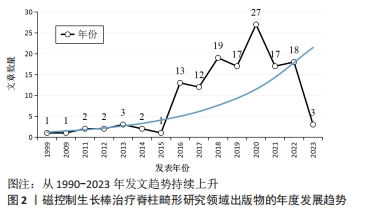
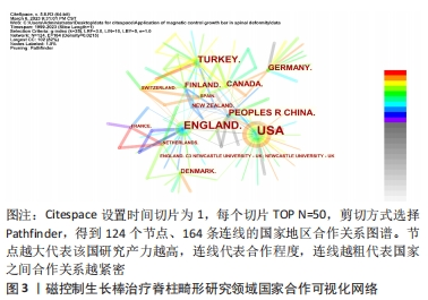
合著分析是反映磁控制生长棒领域学术交集程度的重要形式。为进一步探究各研究团队之间的合作与发展脉络,将所有国家作者进行聚类分析。在聚类视图中,节点间映射中的连接表示合作关系。各节点之间的距离和连接的交互程度揭示了在该领域研究有影响力的国家和作者之间的合作水平,并与其形成正相关的关系。图3-5分别显示了国家和作者的合作者网络联系。不同颜色代表不同的国家地区以及不同的研究团队,用Citespace 5.8软件分析相关数据后如图3,年轮越大代表研究产出值越高、中心性越强,结合表1和图3可知,近几十年来,人们对磁控制生长棒领域的研究热情高涨,大量的出版物集中在亚洲和北美国家。但总体显示联系强度较为有限,表明两者之间的合作都相对较分散,从另一个角度说明国际合作仍需加强。"
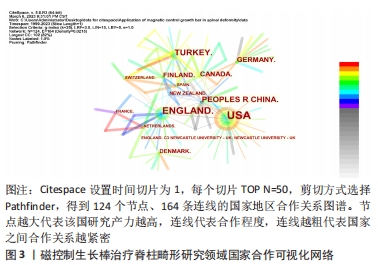
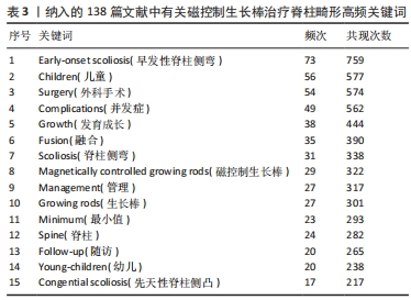
运用 VOSviewer 1.6.19软件对作者进行共现分析,得到核心作者的密度视图,见图4。根据区域的节点数量、彼此联系的紧密程度而有颜色深浅的不同,颜色越深表示作者间合作紧密程度越高,即该区域的研究较成熟。密度视图通过光谱展示核心作者共现密度的强度。Akbarnia BA、Cheung KMC、Nnadi C、Cheung JPY和Yazici M等作者群亮度最高,他们是该领域研究最为活跃的团队,亮度其次是Thompson George H和Sponseller Paul D等作者群,表明该团队研究也较为活跃。在此基础之上,为进一步探究各研究团队之间的合作与发展脉络,将所有核心作者进行聚类分析,最终得到9个不同颜色分组,代表9个相互关联的研究团队,见图5。 2.4 磁控制生长棒在治疗脊柱畸形研究领域关键词共现分析 表3集中反映了磁控制生长棒技术在治疗脊柱畸形领域的前15个高频关键词,其中早发性脊柱侧弯(Early-onset scoliosis)、儿童(Children)、外科手术(Surgery)以及并发症(Complications)等关键词引用频次与共现次数最高,侧重于磁控制生长棒技术的适应证、运用对象、使用方法和并发症之间的探讨与研究,客观真实地反映了磁控制生长棒在治疗脊柱畸形领域的现状和热点,深层次探讨磁控制生长棒技术与脊柱畸形病因分型的对应外科治疗与并发症的防治。"
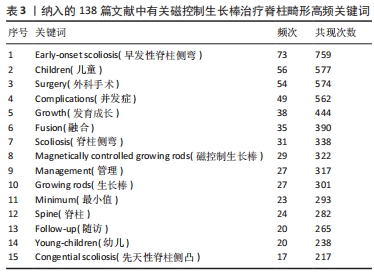

图6显示,除“磁控制生长棒(Magnetically controlled growing rods)”“早发性脊柱侧弯(Early-onset scoliosis)”“儿童(Children)”“外科手术(Surgery)”“融合(Fusion)”“生长(Growth)”“管理(Management)”“多元中心(Multicenter)”“并发症(Complications)”等词外,其他核心关键词均较为分散,链接强度不高。图7是关键词密度视图,区域亮度与关键词频率大小呈正相关,图中显示“早发性脊柱侧弯(Early-onset scoliosis)”“儿童(Children)”“生长棒(Growing rods)”等关键词出现频率最高;图8是关键词时间视图,关键词平均出现的年份越早,节点颜色越偏向深绿色,反之越偏向深黄色,图中显示“早发性脊柱侧弯(Early-onset scoliosis)”“儿童(Children)”“生长棒(Growing rods)”等研究相对较早,集中于2018-2020年,2020-2021年之间“生活质量(Quality of life)”和“大脑性瘫痪(Cerebral palsy)”等关键词是该领域新的研究热点。"
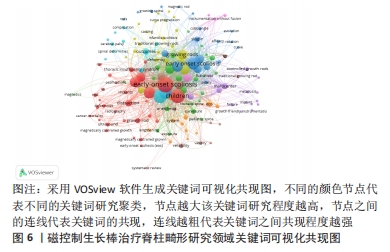
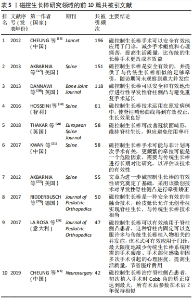
在4个聚类中,聚类的期刊主要涉及临床骨科与关节领域内的期刊,引用这些期刊更加关注的是总结骨科相关疾病的临床治疗策略,强调磁控制生长棒技术的运用对于临床疗效与观察;红色聚类和黄色聚类的期刊主要涉及的是脊柱领域内的期刊,引用这些期刊往往更多的是探讨脊柱畸形病因症状和治疗方法的相互关联,更加深层次地探讨磁控制生长棒技术运用在脊柱畸形矫正领域的大数据分析研究,为临床治疗领域提供更多的技术支持。 2.5.2 文献共被引分析结果 进一步对文献共被引进行分析,使用VOS viewer 1.6.19软件分析出该领域从1998-2023年共被引次数前10名的文献,表5总结了磁控生长棒研究领域的前10篇共被引文献[16-25]。磁控制生长棒研究领域的一篇文章被共被引次数最高,共被引次数为196次。这些共被引频次前10位的文章中有4篇发表在《Spine》杂志上,有2篇发表在《Journal of Pediatric Orthopedics》杂志上,而剩下的杂志发表文章均为1篇。其中,一项研究发表于2019年,其他9篇文章发表于2012-2018年。所有10篇论文都是第一作者与其他作者一起合著,平均作者人数> 3人。10篇高共被引文献中,有2篇文献出自该领域高生产力的学者Akbarnia BA,主要综合讨论磁控制生长棒相较于传统的生长棒在技术上的创新性和有效性分析研究。"
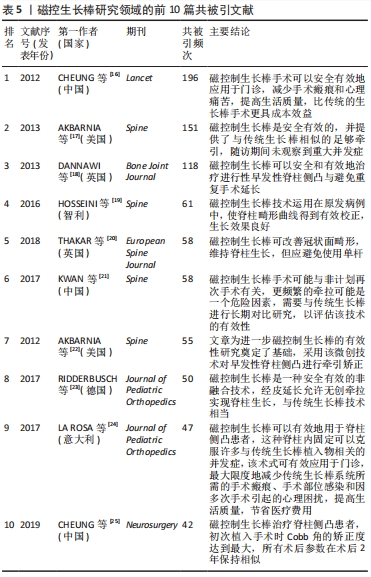
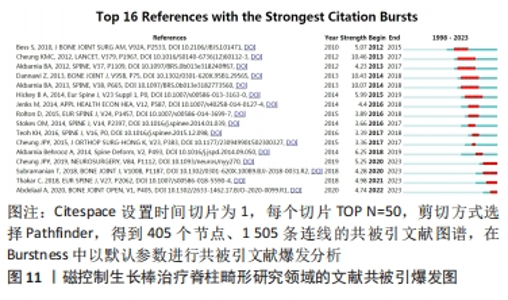
2.5.3 高被引文献深度分析结果 图10可以发现,高共被引文献分为3大聚类,共包括34篇文献,对应图中3种颜色,其中主要涉及是磁控制生长棒技术的临床治疗的研究文献,以及疾病方法研究和综述研究。结合图11可知,文献共被引爆发研究共16篇文献,可分为2个阶段,第一阶段是2012-2019年,代表文献是CHEUNG等[16]于2012年发表,主要研究磁控制生长棒技术的临床治疗的相关内容;第二阶段是2019-2023年,代表文献是CHEUNG等[25]于2019年发表,主要研究磁控制生长棒治疗的并发症监测治疗的相关内容。对高共被引文献的年份进行分析,可以发现大部分高共被引文献发表的时间位于2005-2017年,2017年之后发表文献被引次数达到10次以上的仅有1篇,部分发表于2010年前后的高共被引文献主要为磁控制生长棒技术的治疗运用效果,为矫正脊柱畸形领域提供一种有效的治疗新思路与技术支持。"
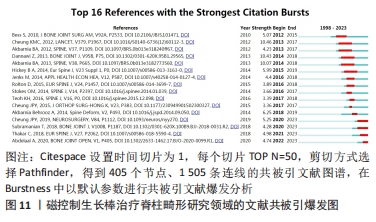

磁控制生长棒在全世界范围内的研究进展路径中分布较为均匀,没有出现某个年份大量出现爆发词的情况,爆发词中强度最大的是磁控制生长棒单杆结构(single),这是由于早期磁控制生长棒技术的运用主要是使用的单杆结构,2016年开始对其包括并发症的相关研究,为后期的磁控制生长棒双杆结构的更进一步的运用奠定了充分的理论与实践基础。2020年开始研究的医学分级(Classification)、2021年开始研究的生活质量(Quality of life)和大脑性瘫痪(Cerebral palsy),进一步说明磁控制生长棒技术在矫正脊柱畸形领域中,更加精准有效地运用到临床患者,并防止相关并发症的发生发展。由图12可知,磁控制生长棒应用的风险因素、医学分级、生活质量和大脑性瘫痪是近年来的研究热点。"

| [1] GLASSMAN SD, BERVEN S, BRIDWELL K, et al. Correlation of radiographic parameters and clinical symptoms in adult scoliosis. Spine J. 2005;30(6):682-688. [2] LOWE T, BERVEN SH, SCHWAB FJ, et al. The SRS classification for adult spinal deformity: building on the King/Moe and Lenke classification systems. Spine J. 2006;31(19):S119-S125. [3] ROUSSOULY P, PINHEIRO-FRANCO JL. Sagittal parameters of the spine: biomechanical approach. Eur Spine J. 2011;20(5):578-585. [4] GROENEFELD B, HELL AK. Ossifications after vertical expandable prosthetic titanium rib treatment in children with thoracic insufficiency syndrome and scoliosis. Spine J. 2013;38(13):E819-E823. [5] MOE JH, KHARMT K, WINTER RB, et al. Harrington instrumentation without fusion plus external orthotie support for the treatment of difficult curvature problems in young children. Clin Orthop J. 1984;(185):35-45. [6] KLEMME WR, DENIS F, WINTER RB, et al. Spinal instrumentation without fusion for progressive scoliosis in young children. J Pediatr Orthop. 1997;17(6):734-742. [7] LORENZ HM, BRAUNSCHWEIG L, BADWAN B, et al. High correlation between achieved and expected distraction using magnetically controlled growth rods (MCGR) with rib to pelvis fixationin pediatric spine deformity. J Pediatr Orthop. 2019;39(5):e334-e338. [8] METKAR U, KURRA S, QUINZI D, et al. Magnetically controlled growing rods for scoliosis surgery. Expert Rev Med Devices J. 2017;14(2):117-126. [9] TSIRIKOS AI, BAKER AD. Spinal muscular atrophy: classification, aetiology, and treatment of spinal deformity in children and adolescents. Curr Orthop J. 2006; 20(6):430-445. [10] PLAASS C, HASLER CC, HEININGER U, et al. Bacterial colonization of VEPTR implants under repeated expansions in children with severe early onset spinal deformities. Eur Spine J. 2016;25(2):549-556. [11] TAKASO M, MORIYA H, KITAHARA H, et al. New remote-controlled growing-rod spinal instrumentation possibly applicable for scoliosis in young children. J Orthop Sci Off J Jpn Orthop Assoc. 1998;3(6):336-340. [12] WICK JM, KONZE J. A magnetic approach to treating progressive early-onset scoliosis. AORN J. 2012;96(2):163-173. [13] Yin M, Xu C, Ma J, et al. A bibliometric analysis and visualization of current research trends in the treatment of cervical spondylotic myelopathy. Global Spine J. 2021;11(6):988-998. [14] LIN GX, KOTHEERANURAK V, MAHATTHANATRAKUL A, et al. Worldwide research productivity in the feld of full‑endoscopic spine surgery: a bibliometric study. Eur Spine J. 2020;29(1):153-160. [15] WEI M, WANG W, ZHUANG Y. Worldwide research productivity in the field of spine surgery: a 10-year bibliometric analysis. Eur Spine J. 2016;25(4):976-982. [16] CHEUNG KM, CHEUNG JP, SAMARTZIS D, et al. Growing trend of China’s contribution to the feld of spine: a Magnetically controlled growing rods for severe spinal curvature in young children: a prospective case series. Lancet J. 2012;379(9830):1967-1974. [17] AKBARNIA BA, CHEUNG K, NOORDEEN H, et al. Next generation of growth-sparing techniques: preliminary clinical results of a magnetically controlled growing rod in 14 patients with early-onset scoliosis. Spine J. 2013;38(8):665-670. [18] DANNAWI Z, ALTAF F, HARSHAVARDHANA NS, et al. Early results of a remotely operated magnetic growth rod in early onset scoliosis. Bone Joint J. 2013;95-B(1): 75-80. [19] HOSSEINI P, PAWELEK J, MUNDIS GM, et al. Magnetically controlled growing rods for early-onset scoliosis: a multicenter study of 23 cases with minimum 2 years follow-up. Spine J. 2016;41(18):1456-1462. [20] THAKAR C, KIESER DC, MARDARE M, et al. Systematic review of the complications associated with magnetically controlled growing rods for the treatment of early onset scoliosis. Eur spine J. 2018;27(9):2062-2071. [21] KWAN KYH, ALANAY A, YAZICI M, et al. Unplanned reoperations in magnetically controlled growing rod surgery for early onset scoliosis with a minimum of two-year follow-up. Spine J. 2017;42(24):E1410-E1414. [22] AKBARNIA BA, MUNDIS GM JR, SALARI P, et al. Innovation in growing rod technique: a study of safety and efficacy of a magnetically controlled growing rod in a porcine model. Spine J. 2012;37(13):1109-1114. [23] RIDDERBUSCH K, RUPPRECHT M, KUNKEL P, et al. Preliminary results of magnetically controlled growing rods for early onset scoliosis. J Pediatric Orthop. 2017;37(8):e575-e580. [24] LA ROSA G, OGGIANO L, RUZZINI L. Magnetically controlled growing rods for the management of early-onset scoliosis: a preliminary report. J Pediatric Orthop. 2017;37(2):79-85. [25] CHEUNG JPY, YIU K , KWAN K, et al. Mean 6-year follow-up of magnetically controlled growing rod patients with early onset scoliosis: a glimpse of what happens to graduates. Neurosurgery. 2019;84(5):1112-1123. [26] BOBBY P, INDRANIL S. Research rating: Some technicalities. Med J Armed Forces India. 2022;78(1):S24-S30. [27] OZGUR D, GOKHAN D, MUHARREM Y. Update on the growing spine surgery for young children with scoliosis. Curr Opin Pediatr J. 2014;26(1):57-63. [28] SCOTT JL, EOIN MM, STACEY JA, et al. Cost analysis of a growth guidance system compared with traditional and magnetically controlled growing rods for early-onset scoliosis: a US-based integrated health care delivery system perspective. Clinicoecon Outcomes Res. 2018;16(10):179-187. [29] WANG C, LIU Q. A turning point for clinical research in China? Lancet. 2013; 382(9895):835-836. [30] JIA ZW, WU YH, LI H, et al. Growing trend of China’s contribution to the feld of spine: a 10-year survey of the literature. Eur Spine J. 2015;24(8):1806-1812. [31] BESS S, AKBARNIA BA, THOMPSON GH, et al. Complications of growing-rod treatment for early-onset scoliosis: analysis of one hundred and forty patients. J Bone Joint Surg Am. 2010;92(15):33-43. [32] MCMASTER MJ, MACNICOL MF. The management of progressive infantile idiopathic scoliosis. J Bone Joint Surg Br. 1979;61(1):36-42. [33] AKBARNIA BA, BREAKWELL LM, MARKS DS, et al. Dual growing rod technique followed for three to eleven years until final fusion: the effect of frequency of lengthening. Spine J. 2008;33(9):84-90. [34] AKBARNIA BA, MARKS DS, BOACHIE-ADJEI O, et al. Dual growing rod technique for the treatment of progressive early-onset scoliosis: a multicenter study. Spine J. 2005;30(17 Suppl): S46-S57. [35] CALDAS JC, PAIS-RIBEIRO JL, CARNEIRO SR. General anesthesia, surgery and hospitalization in children and their effects upon cognitive, academic, emotional and 28 sociobehavioral development - a review. Paediatr Anaesth J. 2004;14(11):910-915. [36] AKBARNIA BA, MUNDIS G, SALARI P, et al. A technical report on the ellipse technologies device: a remotely expandable device for non-invasive lengthening of growing rod. J Child Orthop. 2009;3(6):530-531. [37] PANAGIOTOPOULOU VC, TUCKER SK, WHITTAKER RK, et al. Analysing a mechanism of failure in retrieved magnetically controlled spinal rods. Eur spine J. 2017;26(6):1699-1710. [38] URBANSKI W, TUCKER S, EMBER T, et al. Single vs dual rod constructs in early onset scoliosis treated with magnetically controlled growing rods. Adv clin and Exp Med J. 2020;29(10):1169-1174. |
| [1] | Ouyang Beiping, Ma Xiangyang, Luo Chunshan, Zou Xiaobao, Lu Tingsheng, Chen Qiling. Three-dimensional finite element analysis of a new horizontal screw-screw crosslink in posterior atlantoaxial internal fixation [J]. Chinese Journal of Tissue Engineering Research, 2024, 28(9): 1320-1324. |
| [2] | Niu Hegang, Yang Kun, Zhang Jingjing, Yan Yizhu, Zhang Yinshun. Design of a new posterior atlas fracture reduction and internal fixation system [J]. Chinese Journal of Tissue Engineering Research, 2024, 28(9): 1399-1402. |
| [3] | Wang Menghan, Qi Han, Zhang Yuan, Chen Yanzhi. Three kinds of 3D printed models assisted in treatment of Robinson type II B2 clavicle fracture [J]. Chinese Journal of Tissue Engineering Research, 2024, 28(9): 1403-1408. |
| [4] | Xu Canli, He Wenxing, Wang Lei, Wu Fangting, Wang Jiahui, Duan Xuelin, Zhao Tiejian, Zhao Bin, Zheng Yang. Bibliometric analysis of researches on liver organoids [J]. Chinese Journal of Tissue Engineering Research, 2024, 28(7): 1099-1104. |
| [5] | Sun Yukang, Song Lijuan, Wen Chunli, Ding Zhibin, Tian Hao, Ma Dong, Ma Cungen, Zhai Xiaoyan. Visualization analysis of stem cell therapy for myocardial infarction based on Web of Science in recent ten years [J]. Chinese Journal of Tissue Engineering Research, 2024, 28(7): 1143-1148. |
| [6] | Wang Qiang, Li Shiyun, Xiong Ying, Li Tiantian. Biomechanical changes of the cervical spine in internal fixation with different anterior cervical interbody fusion systems [J]. Chinese Journal of Tissue Engineering Research, 2024, 28(6): 821-826. |
| [7] | Xue Xiaofeng, Wei Yongkang, Qiao Xiaohong, Du Yuyong, Niu Jianjun, Ren Lixin, Yang Huifeng, Zhang Zhimin, Guo Yuan, Chen Weiyi. Finite element analysis of osteoporosis in proximal femur after cannulated screw fixation for femoral neck fracture [J]. Chinese Journal of Tissue Engineering Research, 2024, 28(6): 862-867. |
| [8] | Zheng Jiafa, Song Xiufeng, Li Hongzhi, Zhou Jinming, Guan Shengyi, Yu He. Open reduction and internal fixation via the para-Achilles tendon approach for the treatment of posterior malleolus sandwich fractures [J]. Chinese Journal of Tissue Engineering Research, 2024, 28(6): 934-938. |
| [9] | Yu Zhaoyu, Tan Lixin, Sun Kai, Lu Yao, Li Yong. Meta-analysis of cement-augmented pedicle screw for thoracolumbar degenerative diseases with osteoporosis [J]. Chinese Journal of Tissue Engineering Research, 2024, 28(5): 813-820. |
| [10] | Yang Juncong, Huang Rui, Wu Xie. Visualization of the biomechanical characteristics of long-distance running landing patterns [J]. Chinese Journal of Tissue Engineering Research, 2024, 28(32): 5159-5166. |
| [11] | Tao Guangyi, Wang Linzi, Yang Bin, Huang Junqing. Research hotspots of artificial intelligence in the field of spinal deformity: visual analysis [J]. Chinese Journal of Tissue Engineering Research, 2024, 28(30): 4915-4920. |
| [12] | Qi Yuanbo, Li Jiantao, Liu Daohong, Tao Sheng, Wang Daofeng, Wu Jie. Three internal fixation devices used for finite element analysis of Pauwels type III femoral neck fractures [J]. Chinese Journal of Tissue Engineering Research, 2024, 28(30): 4763-4769. |
| [13] | Ji Xinghua, Wei Jinzheng, Hao Shuai, Xing Zejun. Finite element method predicts the effect of screw placement position in anterior cervical discectomy and fusion on stability of internal fixation [J]. Chinese Journal of Tissue Engineering Research, 2024, 28(30): 4777-4782. |
| [14] | Zhang Zheng, Zhang Daijie, Li Peng. Comparison of percutaneous transverse fixation of a Kirschner wire with miniplate placement for treatment of a fifth metacarpal shaft fracture [J]. Chinese Journal of Tissue Engineering Research, 2024, 28(30): 4842-4847. |
| [15] | Wang Lei, Wang Chenyan, Guo Yuan, Li Xiaona, Chen Weiyi. Biomechanical response of postural kyphosis under the action of bending moments [J]. Chinese Journal of Tissue Engineering Research, 2024, 28(24): 3773-3777. |
| Viewed | ||||||
|
Full text |
|
|||||
|
Abstract |
|
|||||
